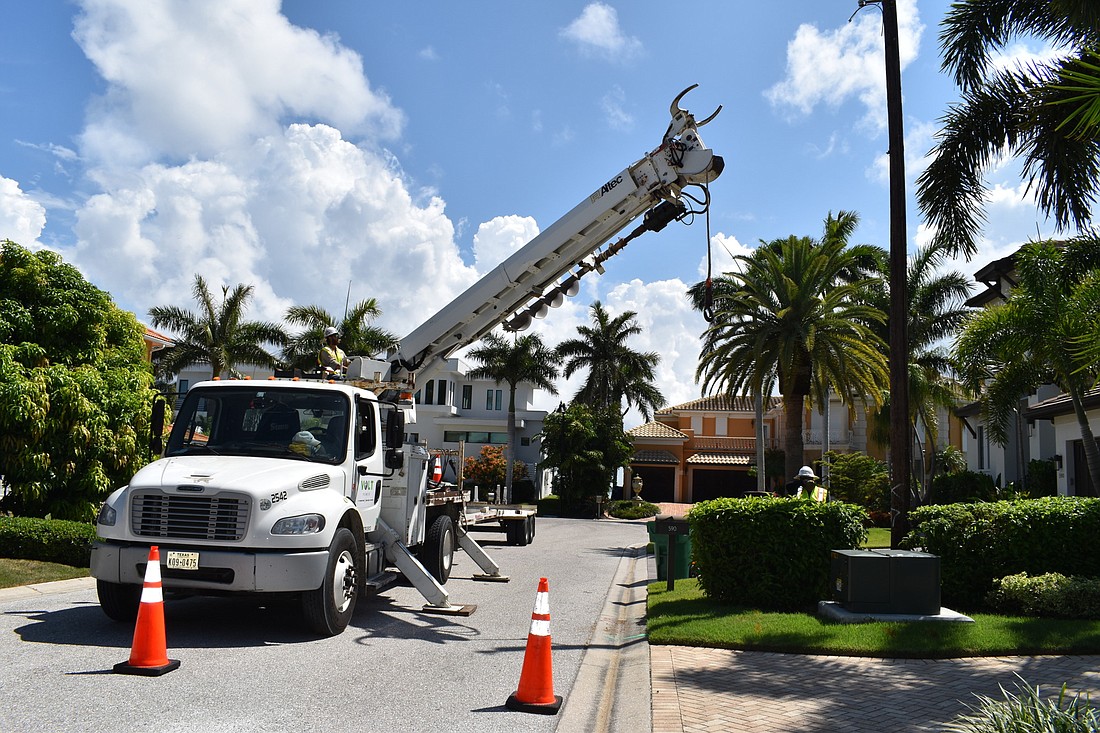- May 1, 2025
-
-
Loading

Loading

It’s been almost a decade since the journey to underground Longboat Key’s utilities began.
Barring any unforeseen delays, the project team hopes to finish this year. With the current timeline, Longboat’s utilities should be fully switched to the underground system in October, and the remaining overhead poles and wires should be removed by the end of December.
Director of Public Works Isaac Brownman is pleased with the recently expedited process, but he said he’s not ready to celebrate.
He will celebrate in phases with his staff when they hit more milestones. First when switching orders are completed, then when the poles are finally taken out.
This summer, Florida Power & Light committed to a more proactive approach to get Longboat’s project finished. A dedicated staff member was assigned to the project, and the company allowed Longboat’s switching orders to be approved in larger batches, and with higher priority than other projects.
“Absolutely we saw a difference, both from the town’s perspective and our contractor’s perspective,” Brownman said. “FPL really went out of its way to streamline its own internal processes.”
The new commitment from FPL came after frustration was expressed by town leaders that the project was behind schedule.
Delays occurred throughout the project, including in June 2023, when Wilco Electrical discovered that some of the town’s existing underground transformers wouldn’t be compatible with the new system.
This required additional transformers to be ordered, and supply chain issues compounded the delay.
Storms also frequently cause delays with FPL projects like Longboat’s undergrounding project, Brownman said. When hurricanes hit the state, FPL diverts resources to help areas in greater need, which sometimes took attention away from Longboat’s project.
Aside from being close to the finish line, Brownman said there are other positives to highlight.
As a part of undergrounding the utility lines, the town opted to add a fiber conduit underground. This system allowed the town to install its own fiber optic network for town facilities, which provides faster service and cost savings for the town.
The underground conduit also provided more space for underground lines that the town could lease out to other providers in the future.
On top of that, the town is running under budget by about $6 million. That surplus figure includes the new purchases for updated street signs and lights that became an additional piece of the island-wide project.
All of these project components required an internal collaboration among town staff, as well as external collaboration with the project team, including FPL and Wilco Electrical.
Undergrounding an island’s utilities isn’t an easy feat.
The project started in November 2015, when the town proposed a referendum for residents to vote on whether or not to allow the town to borrow $25.25 million to pay for the part of the project along Gulf of Mexico Drive.
After that was secured, another referendum in March 2016 gave the town permission to issue bonds not exceeding $23.85 million for the neighborhoods' portion of the project.
This process alone required a lot of work throughout various town departments, Browman said.
Active construction began in July 2019. When construction began, Brownman said an early estimate for an end date was three and a half years.
But, looking back on that estimate, Brownman said figuring out how to properly communicate the project timeline was a learning process.
“The three-and-a-half year target, realistically, was a target to get the bulk of the infrastructure in place, not to have the project completed,” Brownman said.
The end date and timeline of the project could have been communicated better to town commissioners and residents, according to Brownman.
Nevertheless, when construction began, the bulk of the early work involved horizontal directional drilling to get the conduits under the ground.
“One of the early concerns of the project was how many things are going to be hit along the way when we’re touching every single parcel and essentially linear piece of land in the town,” Brownman said.
Though hitting things underground, like water lines, was an early concern, Brownman said the team experienced far fewer hits than expected. When accidental hits did occur, he said the team was quick to respond and remedy the situation.
“A lot of the construction alone was incredibly complex, very time-consuming, very invasive because it touched every single parcel on the island,” Brownman said.
Throughout this time and the remainder of the project, the town had to obtain easements from property owners to complete work on private property. This was another complexity in the process, according to Brownman.
The project team involved not only FPL and Wilco Electrical but also providers like Frontier and Comcast since those lines also had to go underground. Adding in these providers heightened the complexity and the collaboration required among all parties.
After conduits were placed underground, wires had to be pulled through before transformers were placed. Only then is the system ready for the loading and switching phases, which are handled by FPL’s headquarters.
The switching process is sequential, and it’s important for everything to be done correctly and in order, Brownman said.
“It’s an incredibly involved process, and it’s a process that really took the town to understand the timeframes involved with that process, and that’s where FPL has helped us quite a bit to speed up that process,” Brownman said.